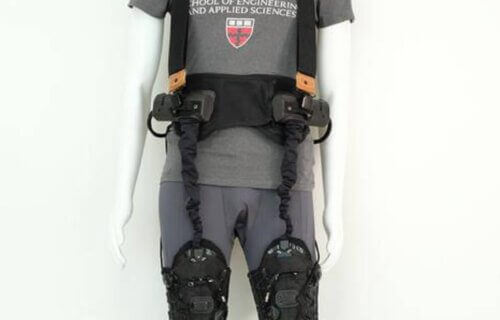BOSTON — Scientists have developed a wearable, robotic device to help people with Parkinson’s disease dealing with mobility issues. The new device is designed to combat the common and debilitating symptom of “freezing” while walking, which can lead to devastating falls.
The neurodegenerative disorder affects over nine million people globally, including one million in the United States. This new apparatus, a form of soft robotic apparel, is worn around the hips and thighs by patients. It gently nudges the hips during leg swings, facilitating longer strides, and enabling wearers to walk faster and further than usual.
“We found that just a small amount of mechanical assistance from our soft robotic apparel delivered instantaneous effects and consistently improved walking across a range of conditions for the individual in our study,” says the co-corresponding author of the study, Conor Walsh from Harvard John A. Paulson School of Engineering and Applied Sciences (SEAS), in a media release.
“The research demonstrates the potential of soft robotics to treat this frustrating and potentially dangerous symptom of Parkinson’s disease and could allow people living with the disease to regain not only their mobility also their independence.”

One study participant, a 73-year-old man who frequently experienced severe freezing episodes leading to falls, reported significant benefits from using the device.
“The suit helps me take longer steps and when it is not active, I notice I drag my feet much more. It has really helped me, and I feel it is a positive step forward. It could help me to walk longer and maintain the quality of my life,” the participant shared after using the exosuit.
The research details how the device utilizes cable-driven sensors around the waist and thighs. These sensors, in conjunction with algorithms, synchronize the device’s assistance with the user’s gait and muscle movements.
“Because we don’t really understand freezing, we don’t really know why this approach works so well. But this work suggests the potential benefits of a ’bottom-up’ rather than ’top-down’ solution to treating gait freezing,” explains Professor Terry Ellis, Physical Therapy Department Chair and Director of the Center for Neurorehabilitation at Boston University. “We see that restoring almost-normal biomechanics alters the peripheral dynamics of gait and may influence the central processing of gait control.”
The findings are published in the journal Nature Medicine.
You might also be interested in:
- Newly discovered Parkinson’s trigger could prevent disease before it takes hold
- Promising wearable device may help people manage Tourette syndrome by 2026
- Walking fast key to a long life? Study links pace to aging
South West News Service writer Imogen Howse contributed to this report.

If they can be remotely controlled such devices can be used to control criminals. They can even be a punishment, for example, by forcing criminals to repeat actions for hours.